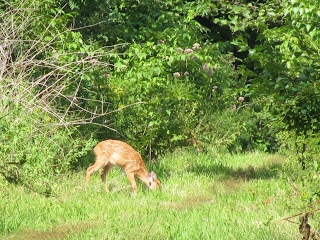
This was the last real day of summer vacation for me (next week I need to start thinking about the fall again). So I decided to do something new and mildly adventurous: visit three of the National Wildlife Refuges in the Sudbury/Wayland area. I enjoy Great Meadows in Concord, so I picked the other two Great Meadows sites, plus
Assabet River.
I started with the Sudbury/Weir Hill NWR, and frankly, was a little disappointed. Unlike Great Meadows in Concord, which is all marsh all the time, the trails at Weir Hill are mostly woodland, with tiny glimpses of the marshland.

Highlights: mushrooms galore (some purplish ones),

a wood frog hopping down the trail, and a (visible) pewee.
The pewees are still singing, but only in fragments.
The full view of Sudbury's Great Meadows, it turns out, is only available from the road (or canoe)--about a mile's worth along Water Row Road. I stopped at the lone viewing point and snapped a photo through my car window.

After Weir Hill, I moved on to the Griscom Trail, also woodland but somehow more pleasant. Probably because of the smaller scale, and the thought of
Ludlow Griscom camping out in May watching for migrating warblers. More glimpses of marshland. Spent some time on the banks of the lovely Heard Pond across the street. Was that a loon out there in the middle of the pond?

(No, just a cormorant, I think).
Onto Assabet River, which I knew nothing about--only that the site looked woody and that it used to be part of Fort Devens. I thought I might walk to "Puffer Pond" and see if I could find a great blue heron to photograph. A friendly NWR rep gave me a photocopied trail map and seemed relieved that I didn't plan to make much use of the trail system. "Very wet," was the message. The pond is accessed through a dirt road, not a trail per se. Along the way, views of an oriole family, the construction of a new NWR visitor center, and abandoned Fort Devens buildings.
The pond was nice, and I caught the glimpse I'd been wanting of a great blue (flying away). But it made me hungry for more. Should I explore the (wet) trails or play it safe and go home? I had my trusty waterproof
Keens on--how muddy could it be?
For me the adventure begins when you go off trail, or at least go down trails that you know most people don't use. In this case, to keep going down the trail meant immediately traversing a 50 yard trail puddle (water from the marsh on one side of the trail spilling into the pond on the other side). Just about enough footing to make it through without submerging the Keens. So when I got to the other side, I had a feeling of exhilaration--finally free to explore!
That feeling lasted for about a half a mile, until I met a similar obstacle, this time with deeper rushing water (pictured below).

I managed to get through by balancing on large sticks on the edges, holding onto stalks of purple loosestrife (finally a use!) and small trees to keep me upright and my feet above water. Onward!
I see another great blue heron flying away.Ten yards later, groan. Impossible. Now the trail puddle was a full fledged brook (pictured below). Water six inches and deeper.

I stood for a good ten minutes on my island trying to figure something out.
Two great blue herons flying away. But the edges lacked enough footing to even try. I would have to wade to proceed (and even the Keens wouldn't do for that). So adventure over, I turned back (and wasn't nearly as careful on the return trip so ended up with soaked feet anyway). When I got home, I found out that this part of the trail was in fact "closed" (no signage, unfortunately, though I imagine the NWR rep would have told me had I asked).
But a good day over all, despite the initial disappointment and the wet feet. My reward on the way back, the great blue heron
not flying away, just standing there waiting to be photographed.




















































